Customer Service Automation Explained for Modern Businesses

Customer service automation uses technology to manage customer interactions and support tasks, streamlining processes for businesses. It leverages tools like AI-powered customer service platforms, chatbots, and self-service systems to handle repetitive queries with speed and accuracy. For instance, chatbots can now manage up to 80% of routine tasks, saving valuable time for human agents to focus on complex issues.
Companies increasingly realize that customer satisfaction hinges on proactive, data-driven approaches like automation in customer service. A retail company, for example, might automate follow-up surveys after purchases, capturing real-time feedback to improve service quality.
Solutions like Sobot’s AI chatbot enhance customer support by providing 24/7 assistance, reducing costs, and boosting efficiency. By integrating such tools, businesses can deliver seamless customer experiences while scaling operations effortlessly.
What Is Customer Service Automation?
Definition and Core Features
Customer service automation uses technology to manage tasks that typically require human intervention. This includes AI-powered customer service platforms and chatbots that provide instant responses to common inquiries. Automation streamlines processes like ticket routing and appointment scheduling, reducing the workload on human agents. It offers 24/7 support, improving customer satisfaction by providing immediate assistance. The primary goal is to handle routine queries, allowing human agents to focus on complex interactions.
- Core Features:
- AI agents specializing in different customer service aspects.
- Instant responses to inquiries, enhancing customer experience.
- Streamlined processes for efficiency and cost reduction.
Forrester Research found that 63% of companies using AI for customer service saw a boost in customer satisfaction.
How Automation in Customer Service Works
Automation in customer service involves AI, chatbots, and other tools to create efficient support experiences. Here's how it works:
- AI Technology: Provides quick, personalized support, fostering human connections that build customer loyalty.
- Natural Language Processing (NLP): Understands and responds to inquiries in a human-like manner.
- Predictive Analytics: Personalizes support and identifies high-priority issues.
- Resource Allocation: Frees human agents to focus on complex tasks, improving efficiency.

Automation reduces wait times and lowers customer service costs by handling routine inquiries. It provides faster, smarter, and more consistent customer experiences.
Examples of Automated Customer Service Processes
Automated customer service processes enhance operational efficiency across industries. For instance, a leading U.S. healthcare equipment provider implemented Intelligent Automation solutions to improve workflows. This resulted in quicker claim processing and improved patient satisfaction.
- Examples:
- Predictive Analytics: Forecasts client needs and potential support tickets.
- Automated Ticketing Solutions: Assigns support tickets to the most appropriate agent.
- AI-Powered Chatbots: Responds to inquiries and suggests helpful articles.
- Automated Feedback Tools: Collects and analyzes customer feedback.
- Interactive Voice Response Software: Guides callers to the appropriate department.
These processes demonstrate the effectiveness of automation in real-world scenarios, showcasing its ability to enhance customer service processes and improve overall satisfaction.
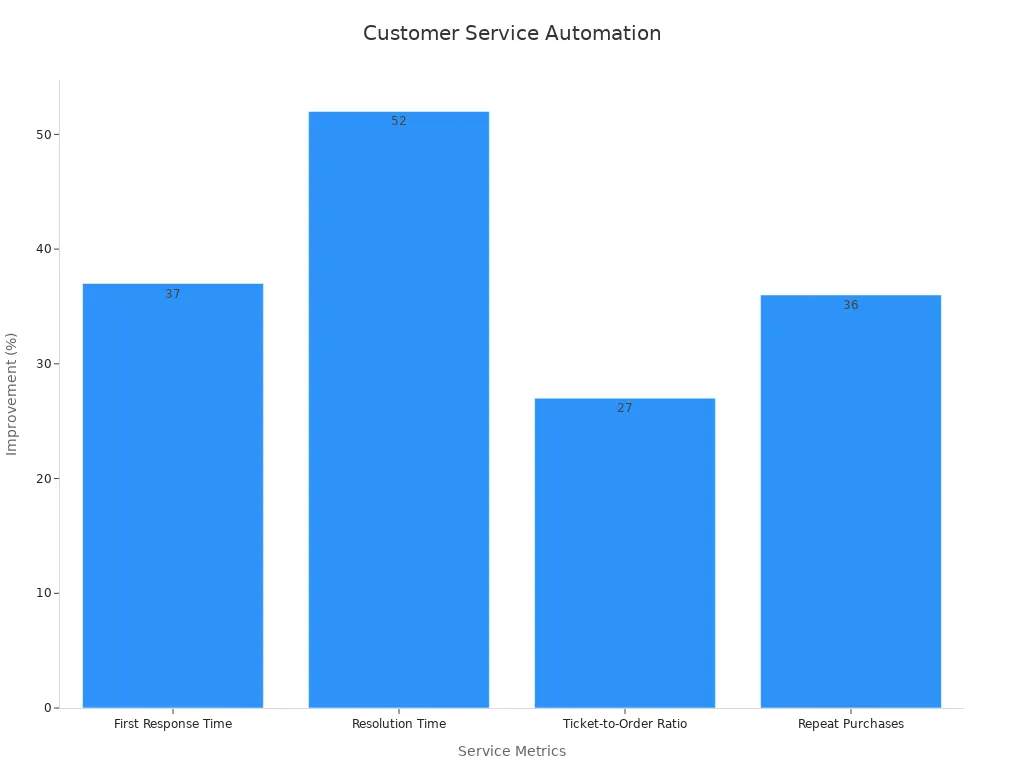
Benefits of Customer Service Automation
Enhanced Efficiency and Productivity
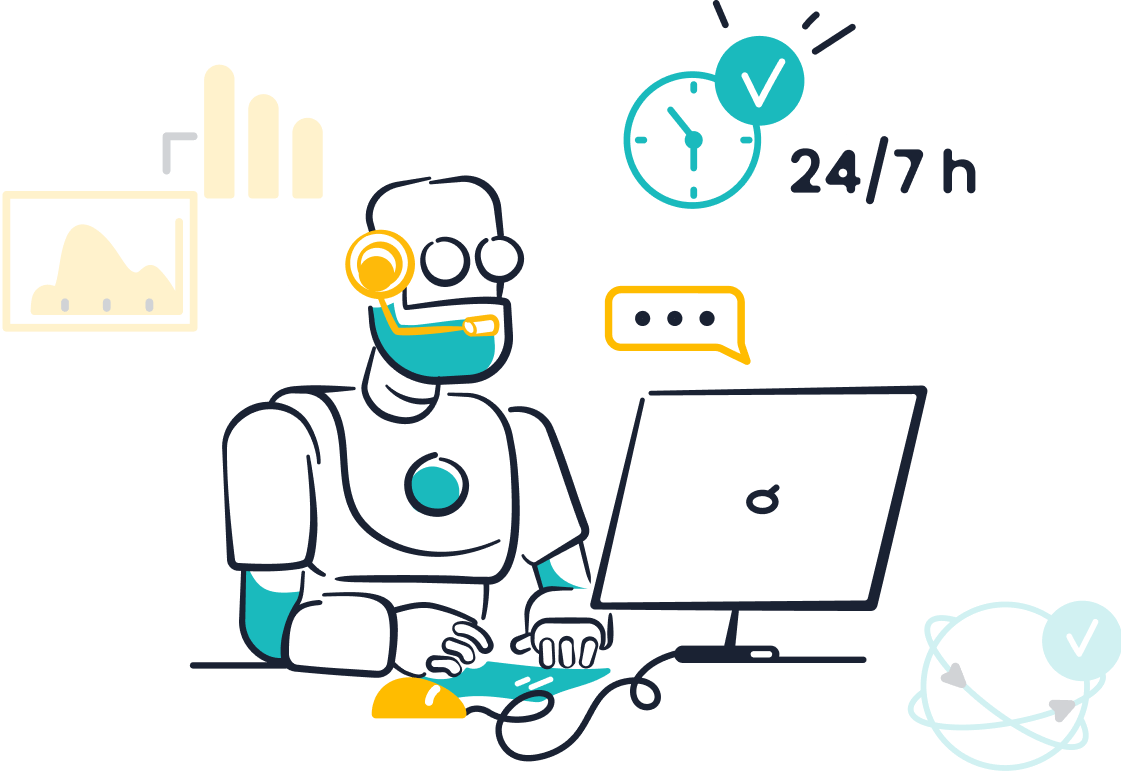
Customer service automation significantly boosts efficiency and productivity by automating repetitive tasks. Automated systems handle routine queries, freeing up your team to focus on complex customer interactions. For example, AI-powered chatbots like Sobot's Chatbot can resolve up to 70% of regular inquiries autonomously, reducing agent workload and improving response times.
A study revealed that 78% of business leaders observed a positive impact of automation on productivity, while 85% agreed it allowed employees to focus on strategic goals. Additionally, 65% of knowledge workers reported feeling less stressed when automation took over repetitive tasks.
| Statistic | Description |
|---|---|
| 78% of business leaders | Report a positive impact of automation on overall productivity. |
| 85% of business leaders | Agree that automation allows employees to focus on strategic goals. |
| 65% of knowledge workers | Feel less stressed when automating repetitive tasks. |
| 90% of knowledge workers | Agree that automation has significantly improved their work lives. |
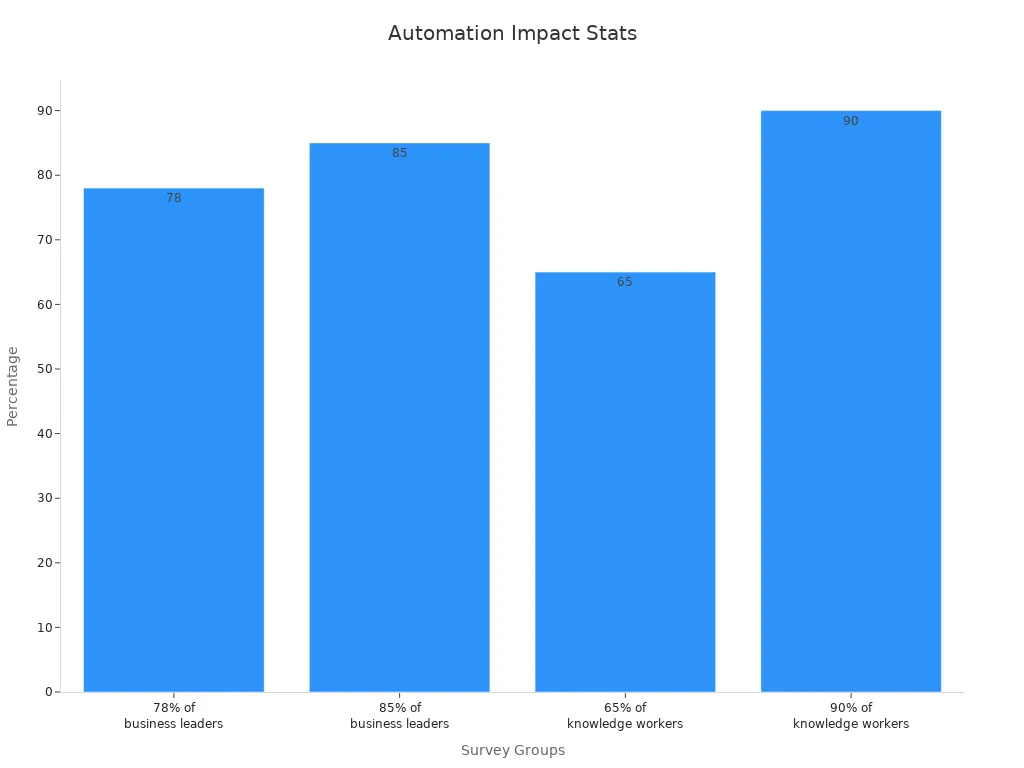
By implementing tools like Sobot's omnichannel solutions, you can streamline workflows and improve team productivity by up to 30%. These tools unify customer data and communication channels, enabling faster resolutions and better resource allocation.
Improved Customer Experience
Automation in customer service enhances the customer experience by providing faster, more accurate responses. Automated systems like chatbots and self-service portals ensure customers receive immediate assistance, even outside business hours. This 24/7 availability reduces wait times and increases satisfaction.
According to a McKinsey study, companies that adopt automated customer service see a 10-20% increase in customer satisfaction scores. For instance, Sobot's AI Chatbot uses natural language processing (NLP) to understand and respond to inquiries in a human-like manner, creating a seamless experience for users. It also offers multilingual support, ensuring customers can communicate in their preferred language.
Tip: Automation doesn't just solve problems—it anticipates them. Predictive analytics can identify potential issues before they arise, allowing you to offer proactive support.
By integrating automation, you can foster loyalty and trust, as customers appreciate quick and efficient service. This approach not only improves satisfaction but also encourages repeat business.
Cost Savings and Scalability for Businesses
Automated customer service reduces operational costs while enabling businesses to scale efficiently. Automation minimizes the need for human agents to handle routine tasks, allowing you to allocate resources to more strategic areas. For example, Sobot's Chatbot operates 24/7, saving up to 50% on additional agent costs.
| Benefit Type | Description |
|---|---|
| Improvement in Processing Time | Automated systems prioritize rapid responses, ensuring that customer queries are addressed swiftly. |
| Increase in Resolution Rates | A well-implemented automation system can free up to 30% of an agent’s time, leading to higher productivity and better resolution rates. |
| Cost Reduction | Automation can lead to substantial cost savings by minimizing errors and reducing the need for a large support staff. |
Automation also supports scalability. As your business grows, automated systems can handle increased volumes of customer interactions without requiring additional hires. This scalability ensures consistent service quality, even during peak periods. For example, OPPO, a global smart device leader, achieved an 83% chatbot resolution rate and a 57% increase in repurchase rate after implementing Sobot's solutions.
Note: Automation not only saves costs but also enhances operational efficiency, making it a valuable investment for businesses of all sizes.
By adopting customer service automation, you can achieve a balance between cost-effectiveness and exceptional service delivery, ensuring long-term success.
Tools and Technologies for Automated Customer Service
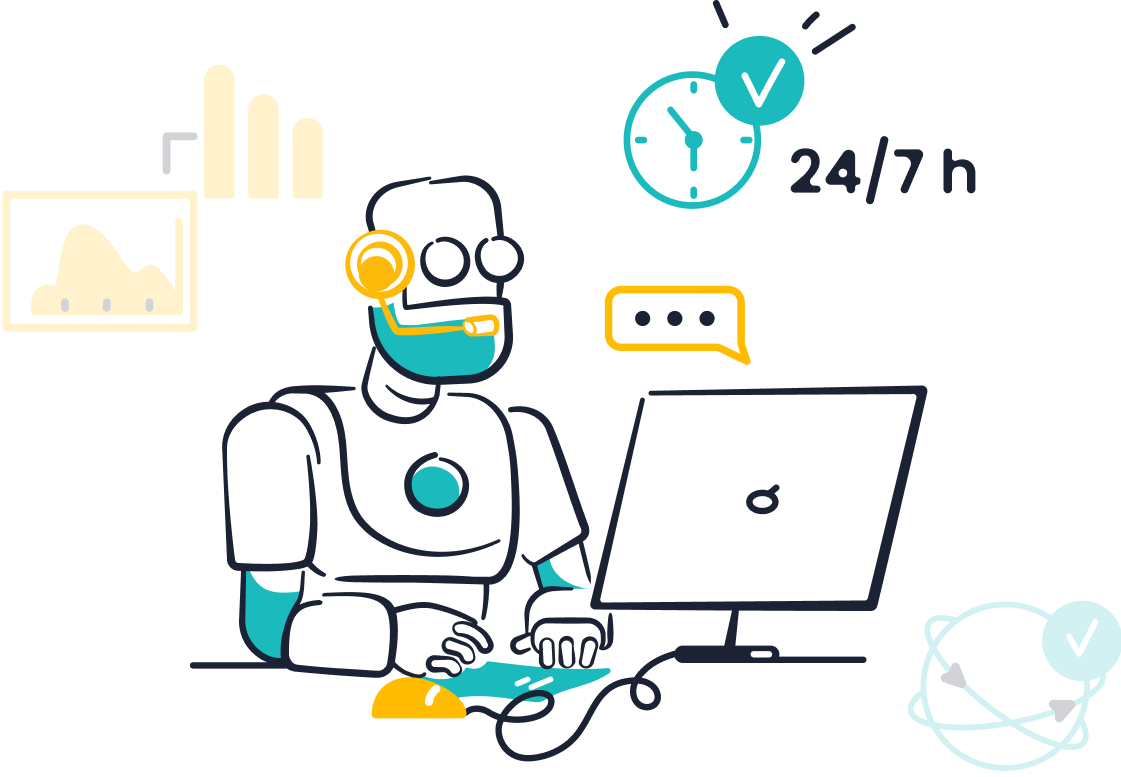
Sobot Chatbot: A Game-Changer in Automation
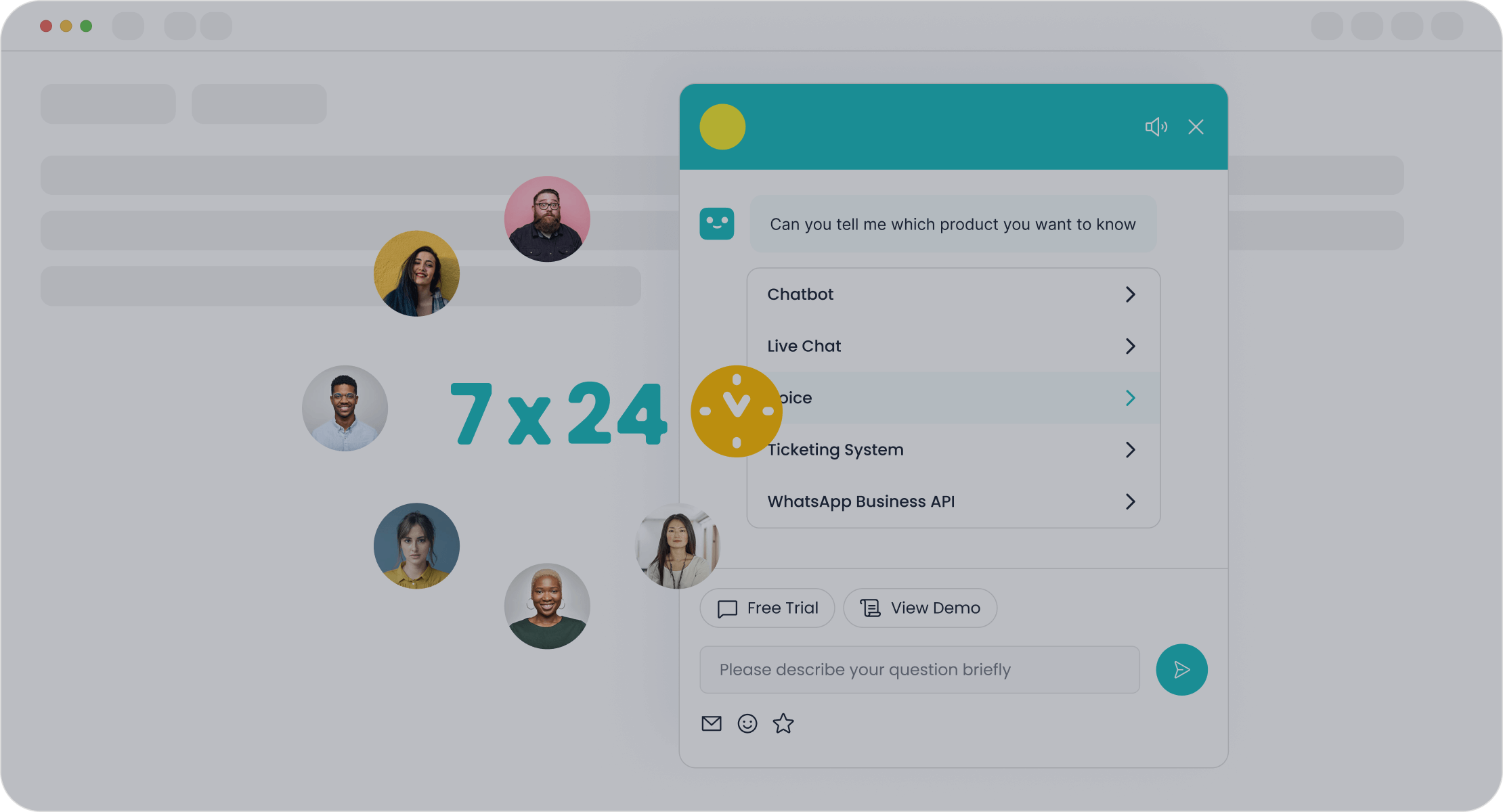
The Sobot Chatbot revolutionizes automated customer service by delivering efficiency, accuracy, and scalability. It autonomously handles routine queries, reducing inbound discussions by 20% and achieving a 96% positive feedback rate. With multilingual support and 24/7 availability, it ensures customers receive instant responses, enhancing satisfaction. Its AI-powered capabilities also improve problem resolution rates, reaching 85%, while boosting customer happiness to an impressive 99%.
| Metric | Value |
|---|---|
| Reduction in inbound discussion | 20% |
| Positive feedback rate | 96%+ |
| Correct answers rate | 80% |
| Customer satisfaction (CSAT) | 97% |
| Problem resolution rate | 85% |
| Customer happiness rate | 99% |
| Sign-off rate increase | 35% |
| COD collection rate increase | 40% |
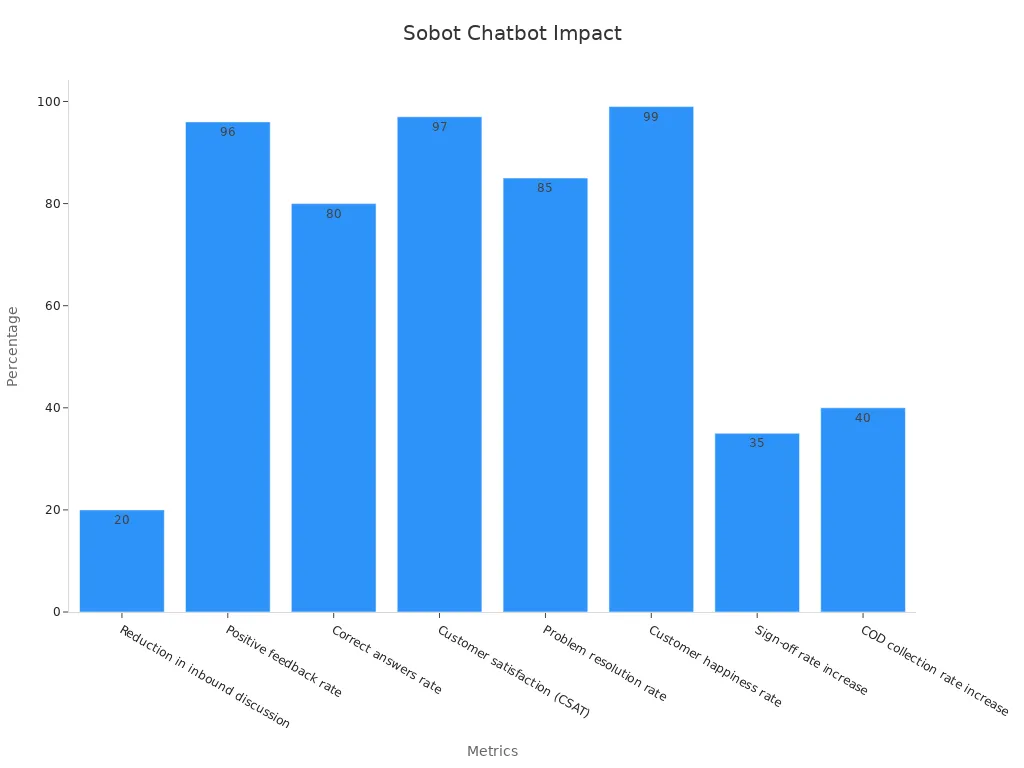
By integrating Sobot’s Chatbot, you can reduce costs, improve customer satisfaction, and scale operations effortlessly. Its no-coding-required setup makes it accessible for businesses of all sizes, ensuring seamless implementation.
Self-Service Portals and Knowledge Bases
Self-service portals and knowledge bases empower customers to find solutions independently, reducing response times and enhancing satisfaction. These tools provide documented fixes and troubleshooting guides, enabling quicker resolutions. For example, internal knowledge bases allow staff to locate information rapidly, minimizing hold times. External portals offer 24/7 access to solutions, eliminating wait times for responses.
| Evidence Type | Description |
|---|---|
| Quicker Solutions | Direct access to documented fixes allows for faster troubleshooting, resolving issues in minutes. |
| Faster Resolution Times | Internal knowledge bases enable staff to quickly find information, minimizing hold times and improving response quality. 90% of customers find 10 minutes acceptable for a reply. |
| 24/7 Availability | External knowledge bases provide users with access to solutions at any time, eliminating wait times for responses. |
| Increased Customer Satisfaction | Easy access to self-help content and fast support enhances customer satisfaction, with 93% of loyal customers citing service as a key differentiator. |
Sobot’s solutions include AI-driven knowledge bases that optimize workflows and reduce maintenance efforts by up to 90%. These tools ensure customers receive accurate and timely assistance, fostering loyalty and trust.
CRM Integration and Analytics Tools
CRM integration and analytics tools enhance automated customer service by consolidating customer data for personalized experiences. Integrated systems improve segmentation, enabling targeted communication and faster issue resolution. Businesses can tailor post-purchase support and shopping experiences based on buying history, increasing satisfaction and loyalty.
| Benefit | Description |
|---|---|
| Enhanced Customer Segmentation | Integrated data allows for more accurate customer profiles, improving targeting and engagement. |
| Faster Resolution Times | Customer support has access to complete customer details, leading to quicker issue resolution. |
| Personalized Experiences | Businesses can tailor communications based on integrated customer data, improving satisfaction. |
| Efficient Post-Purchase Support | Integration ensures customer support has all necessary details for faster resolution of queries. |
| Personalized Shopping Experience | Customer data is updated automatically, allowing for tailored offers based on buying history. |
CRM analytics tools also monitor customer service practices, refining approaches based on satisfaction metrics. Sobot’s omnichannel solutions unify customer data across platforms, enabling seamless communication and boosting productivity by 30%.
How to Implement Customer Service Automation Effectively
Assessing Business Needs and Goals
Before implementing customer service automation, you need to evaluate your business needs and goals. This step ensures that automation aligns with your objectives and delivers meaningful value. Start by identifying specific challenges in your customer support processes. For example, if your team spends excessive time on repetitive tasks, automation can free up resources for more strategic activities.
Create a roadmap for automation initiatives. List the processes you want to automate and define measurable outcomes. For instance, reducing invoice processing time by 50% can increase efficiency and lower costs. Similarly, reallocating 30 hours weekly to high-value tasks can enhance team productivity. Use the table below to understand how goals translate into tangible impacts:
| Goal | Impact |
|---|---|
| Save $15,000 annually by reducing errors | Improves accuracy and reduces costs |
| Increase customer satisfaction or retention | Boosts overall business performance |
By aligning automation with your goals, you can ensure a structured and successful implementation.
Choosing the Right Tools Like Sobot Chatbot

Selecting the right tools is crucial for optimizing customer service automation. Look for solutions that offer predictive intelligence, seamless CRM integration, and advanced natural language processing. For example, Sobot Chatbot uses predictive analytics to anticipate customer needs and provide proactive solutions. It also handles up to 70% of inquiries automatically, allowing your team to focus on complex issues.
When evaluating tools, consider their scalability and ease of integration with your existing systems. Sobot’s omnichannel solutions unify customer data across platforms, ensuring smooth operations. Additionally, its AI-powered chatbot enhances customer experience by offering multilingual support and 24/7 availability. These features make it an ideal choice for businesses aiming to implement the best practices to automate customer service.
| Criteria/Statistics | Description |
|---|---|
| Predictive Intelligence | Anticipates customer needs and offers proactive solutions |
| CRM Integration | Ensures seamless operation within existing systems |
| Automatic Inquiry Handling | Manages up to 70% of inquiries automatically |
Choosing tools like Sobot Chatbot ensures efficiency, scalability, and improved customer satisfaction.
Training Teams and Monitoring Performance
Training your team is essential for the success of customer service automation. Equip employees with the knowledge to use new tools effectively. For example, training programs can improve knowledge retention and enhance on-the-job performance. Over 75% of employees who complete training courses report better operational efficiency.
Monitor performance metrics to ensure the automation system meets your goals. Track KPIs like bot uptime, error rates, and customer satisfaction scores. For instance, reducing missed deadlines from 40% to 20% demonstrates improved efficiency. Regularly review these metrics to identify areas for improvement and optimize your automation strategy.
| Metric | Outcome |
|---|---|
| Knowledge Retention | Improved post-training retention |
| Operational Efficiency | Reduced missed deadlines |
| Training Satisfaction (NPS) | Scores above 30 are excellent |
By training your team and monitoring performance, you can maximize the benefits of automation and continuously refine your approach.
Continuous Optimization and Updates
Customer service automation systems require regular updates to stay effective and relevant. Continuous optimization ensures your tools adapt to changing customer needs and evolving business goals. By monitoring key performance indicators (KPIs), you can identify areas for improvement and refine your automation strategy.
Why Optimization Matters
Customer expectations shift over time. Automation tools must evolve to meet these demands. For example, updating your chatbot’s knowledge base ensures it provides accurate answers as your products or services change. Regular updates also improve efficiency, reducing processing times and enhancing customer satisfaction.
Tip: Use analytics to track customer behavior changes. Early detection of trends helps you adjust your automation tools proactively.
Key Metrics to Monitor
Tracking KPIs allows you to measure the effectiveness of your automation systems. Below are some essential metrics:
| KPI | Description |
|---|---|
| Customer Behavior Changes | Identifies shifts in customer needs and potential issues early on. |
| First Response Time (FRT) | Measures the speed of initial customer interaction, indicating efficiency. |
| Processing Time | Assesses the duration taken to resolve customer queries, highlighting areas for improvement. |
| KPI | Description |
|---|---|
| Customer Satisfaction | Evaluates overall customer happiness, guiding service enhancements. |
| Training Needs | Identifies areas where customer service teams may require additional training based on performance metrics. |
| Communication Channels | Assesses the effectiveness of various channels used for customer interaction, indicating where updates may be necessary. |
How Sobot Supports Optimization
Sobot’s solutions simplify the optimization process. For instance, its AI-powered chatbot uses analytics to provide customer experience insights. These insights reveal areas needing improvement, such as response times or communication gaps. Sobot’s omnichannel tools unify data across platforms, making updates seamless and efficient. By leveraging these features, you can maintain high customer satisfaction and operational efficiency.
Note: Regular updates to automation systems not only improve performance but also ensure scalability as your business grows.
Continuous optimization keeps your customer service automation tools aligned with your goals. By refining processes and updating systems, you can deliver exceptional service while staying ahead of industry trends.
Challenges of Customer Service Automation
Balancing Automation with Human Interaction
Automated customer service offers efficiency, but finding the right balance between automation and human interaction remains a challenge. While younger customers often embrace automated tools, older customers tend to prefer speaking with a real person. This generational divide highlights the importance of tailoring your approach to meet diverse customer preferences.
Human agents excel at resolving complex issues. For example, troubleshooting technical problems or handling serious complaints often requires empathy and critical thinking, which AI cannot replicate. Studies show that 86% of clients prefer interacting with a human for customer support, especially when dealing with sensitive matters. Clearly defining the roles of AI and human agents ensures smoother customer interactions and prevents confusion.
Tip: Use automation for routine tasks, such as FAQs, while reserving human agents for nuanced or high-stakes situations. This strategy enhances both efficiency and customer satisfaction.
Addressing Technical Issues and Downtime
Technical issues and downtime can disrupt automated customer service systems, impacting both internal operations and customer-facing services. Prolonged downtime not only damages your company’s reputation but also risks losing customer trust. For businesses reliant on online sales, extended outages can result in significant revenue loss.
Effective data governance plays a crucial role in minimizing downtime. Automation tools like Sobot’s AI Chatbot provide 24/7 customer support, ensuring uninterrupted service. These tools resolve a high percentage of inquiries autonomously, improving response times and customer satisfaction. However, regular system maintenance and monitoring are essential to prevent unexpected disruptions.
Note: Investing in robust infrastructure and backup systems can safeguard your operations against downtime, ensuring business continuity and a positive customer experience.
Ensuring Data Security and Privacy
Data security is a critical concern in automated customer service. With cybercrime costs projected to reach $10.5 trillion by 2025, protecting customer data has never been more important. Breaches involving personal identifiable information account for 46% of incidents, highlighting the need for stringent security measures.
| Statistic | Value |
|---|---|
| Projected global cost of cybercrime (2025) | $10.5 trillion |
| Average cost of a data breach (2024) | $4.88 million |
| Percentage of breaches involving PII | 46% |
| Average time to identify a breach | 204 days |
| Average time to contain a breach | 73 days |
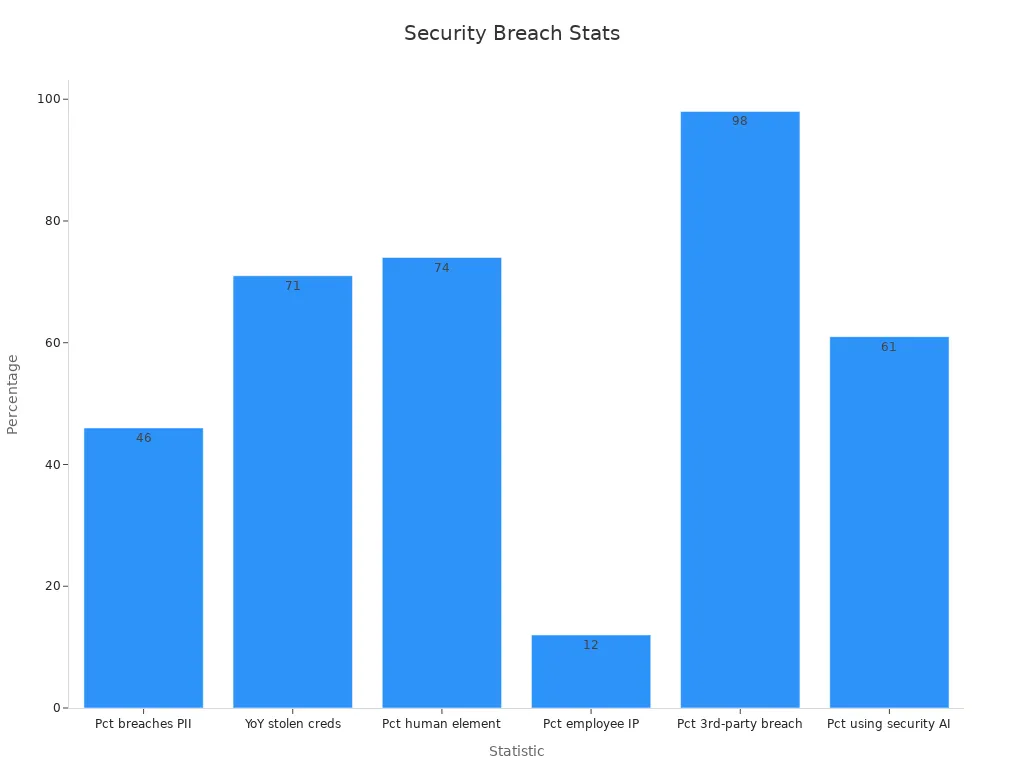
Sobot’s solutions prioritize data security by integrating advanced encryption and compliance measures. Regular audits and updates ensure your systems remain secure, protecting both your business and your customers.
Future Trends in Customer Service Automation

Advancements in AI and Natural Language Processing
AI and natural language processing (NLP) are transforming automated customer service. These technologies enable systems to understand and respond to inquiries in a human-like manner, improving accuracy and efficiency. For example, AI-powered tools can analyze customer interactions to calculate satisfaction scores based on tone and resolution time. Sentiment analysis detects emotional cues, helping you address frustration or satisfaction in real-time. Conversation summary generation simplifies transcripts, allowing faster issue resolution. Intent categorization tracks trends and identifies common concerns, ensuring proactive support.
| Advancement Type | Description |
|---|---|
| AI-Powered Automation | Tools that calculate customer satisfaction scores by analyzing interactions, considering tone and resolution time. |
| Sentiment Analysis | Real-time analysis of customer interactions to detect emotional cues like frustration or satisfaction. |
| Conversation Summary Generation | Automatic summarization of chat and phone transcripts to aid in understanding customer issues. |
| Intent Categorization | Categorization of conversations based on intent to track trends and calculate average satisfaction scores. |
These advancements make automated customer service smarter and more responsive, ensuring customers receive timely and personalized assistance.
The Role of Omnichannel Solutions in Automation
Omnichannel solutions are essential for modern customer service automation. They unify communication channels, allowing you to provide seamless support across platforms like email, social media, and live chat. Customers expect consistent service, whether they contact you via WhatsApp or SMS. By integrating omnichannel tools, you can centralize customer data, enabling faster resolutions and personalized experiences.
Sobot’s omnichannel solutions streamline workflows by consolidating customer interactions into a unified workspace. This approach boosts productivity by 30% and ensures 24/7 availability, meeting immediate demands. Automated systems handle high volumes of inquiries efficiently, reducing the need for large customer service teams. Customers appreciate the convenience of accessing support through their preferred channels, enhancing their overall experience.
Increased Personalization Through Data Insights
Personalization is the future of automated customer service. By leveraging data insights, you can create tailored experiences that resonate with your audience. A powerful customer data platform (CDP) transforms raw data into actionable insights, helping you understand customer behaviors and preferences. This enables you to optimize campaigns and adapt strategies effectively.
- A CDP creates a holistic view of customers, analyzing behaviors and preferences to improve decision-making.
- It helps marketers optimize campaigns and adapt strategies based on data-driven insights.
- Accenture predicts companies could gain $2.95 trillion by personalizing customer experiences.
- 40% of U.S. consumers have purchased more expensive items due to personalized service.
For example, the fashion brand NA-KD achieved a 72X ROI within 12 months by using personalization features, increasing customer lifetime value by 25%. Sobot’s AI chatbot enhances personalization by offering multilingual support and proactive messaging, ensuring customers feel valued and understood.
Predictive Customer Service and Proactive Support
Predictive customer service uses data insights to anticipate customer needs and resolve issues before they arise. This proactive approach enhances customer satisfaction and builds loyalty by addressing concerns early. For example, if a customer frequently contacts support about a product feature, predictive analytics can identify this pattern and offer a solution before the next inquiry.
Proactive support relies on metrics like Customer Satisfaction (CSAT) and Net Promoter Score (NPS) to measure success. These metrics help you understand how well your automation tools meet customer expectations. Other key indicators include:
- Rate of Automated Resolution (ROAR): Tracks the percentage of cases resolved through automation.
- Customer Lifetime Value (CLV): Reflects the revenue impact of proactive service on high-value customers.
- Customer Retention: Shows how proactive support improves loyalty and reduces churn.
| Metric | Description |
|---|---|
| First Response Time (FRT) | Measures how quickly your team responds to initial inquiries, impacting satisfaction. |
| Customer Effort Score (CES) | Evaluates how easy it is for customers to resolve their issues, with lower scores indicating better service. |
| Ticket Backlog | Tracks unresolved tickets, signaling potential resource shortages or inefficiencies. |
| Customer Feedback Trends | Analyzes feedback to identify service strengths and areas for improvement. |
Proactive support also improves customer perception. A study by inContact found that 75% of customers who received proactive outreach reported a better view of the company. McKinsey’s research revealed that 70% of buying experiences depend on how customers feel they are treated.
Sobot’s AI-powered chatbot excels in predictive customer service. It uses advanced analytics to identify patterns and provide real-time solutions. For instance, it can send proactive reminders or suggest helpful resources based on customer behavior. This approach not only resolves issues faster but also boosts satisfaction and loyalty. By integrating tools like Sobot’s chatbot, you can transform your customer service into a proactive, predictive powerhouse.
Tip: Use predictive analytics to identify common customer pain points. Addressing these proactively can significantly enhance satisfaction and retention.
Customer service automation has become essential for modern businesses aiming to enhance efficiency, reduce costs, and improve customer satisfaction. Automated systems streamline operations, allowing teams to focus on complex tasks while ensuring quicker responses and consistent service quality. For instance, automation can prevent up to 67% of customer churn by resolving cases on the first engagement. Businesses also save up to 50% on service costs and reduce the cost per interaction compared to manual handling.
Sobot’s AI-powered chatbot exemplifies the transformative power of automation. It operates 24/7, engages customers proactively, and aligns communication with your brand identity. By adopting tools like Sobot’s solutions, you can future-proof your operations, adapt to changing demands, and foster loyalty through seamless customer experiences. Automation isn’t just a tool—it’s a strategy for staying competitive in an evolving market.
Tip: Start small by automating routine tasks, then scale up to integrate advanced tools like Sobot’s omnichannel solutions for maximum impact.
FAQ
What is customer service automation?
Customer service automation uses technology like AI and chatbots to handle repetitive tasks. It provides instant responses, reduces agent workload, and improves efficiency. For example, Sobot’s AI Chatbot resolves up to 70% of routine queries autonomously, saving time and enhancing customer satisfaction.
How does automation improve customer satisfaction?
Automation ensures faster responses and 24/7 availability. Tools like Sobot’s omnichannel solutions unify communication channels, enabling seamless support. According to McKinsey, companies using automation see a 10-20% increase in customer satisfaction scores, as customers value quick and accurate assistance.
Can automation reduce operational costs?
Yes, automation minimizes the need for additional agents by handling routine tasks. Sobot’s Chatbot operates 24/7, saving up to 50% on agent costs. It also reduces errors and improves efficiency, making it a cost-effective solution for businesses of all sizes.
Is customer service automation scalable?
Automation scales effortlessly with your business. Tools like Sobot’s solutions handle increased customer interactions without requiring extra hires. For instance, OPPO achieved an 83% chatbot resolution rate during peak shopping periods, showcasing the scalability of automated systems.
How do I choose the right automation tools?
Evaluate your business needs and goals. Look for tools with features like predictive analytics, multilingual support, and CRM integration. Sobot’s AI Chatbot offers these capabilities, making it an ideal choice for businesses aiming to enhance efficiency and customer satisfaction.
See Also
Understanding The Efficiency Of Call Center Automation
Enhancing Efficiency With AI Customer Service Solutions
Transforming Customer Support With AI Service Agents
